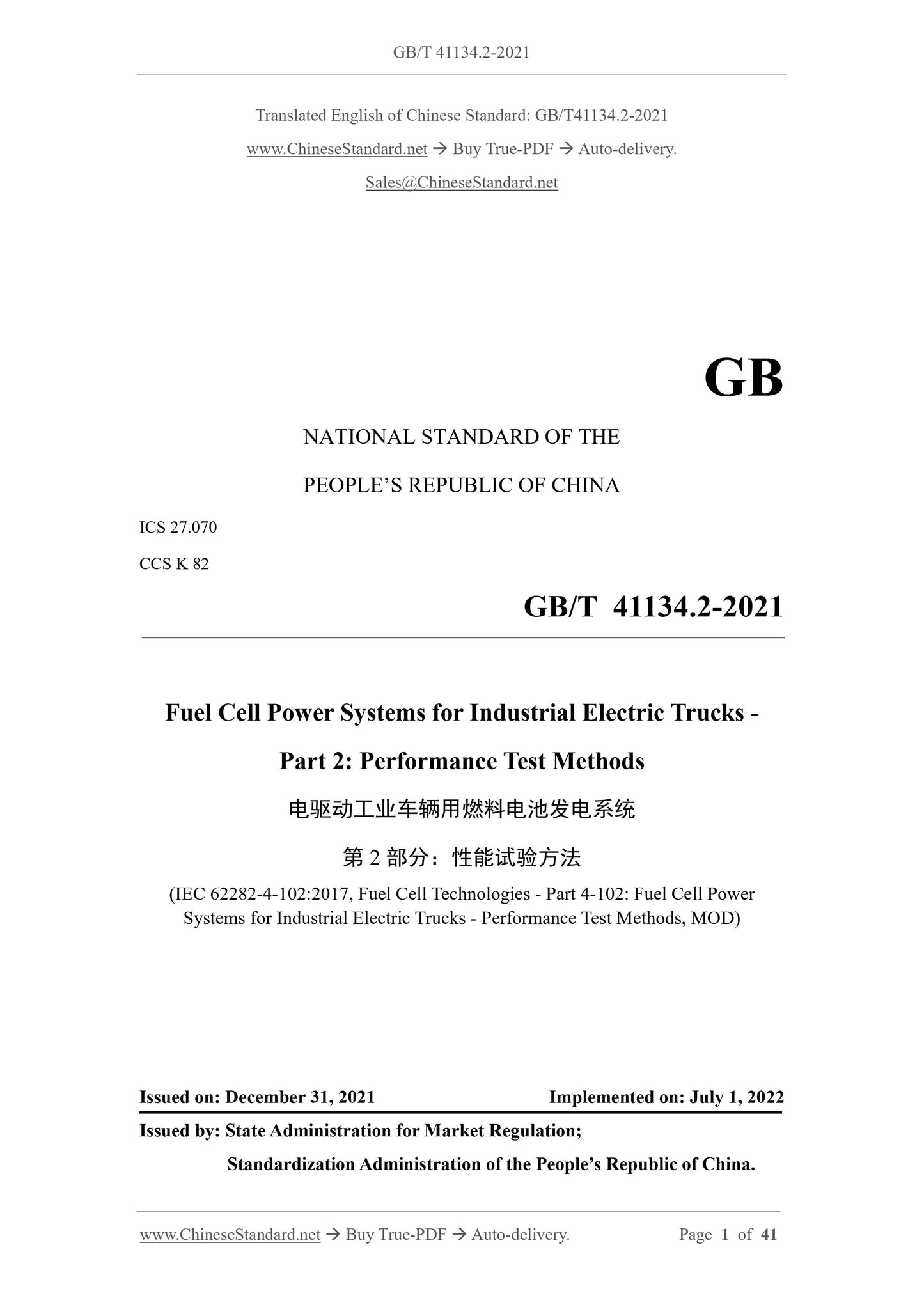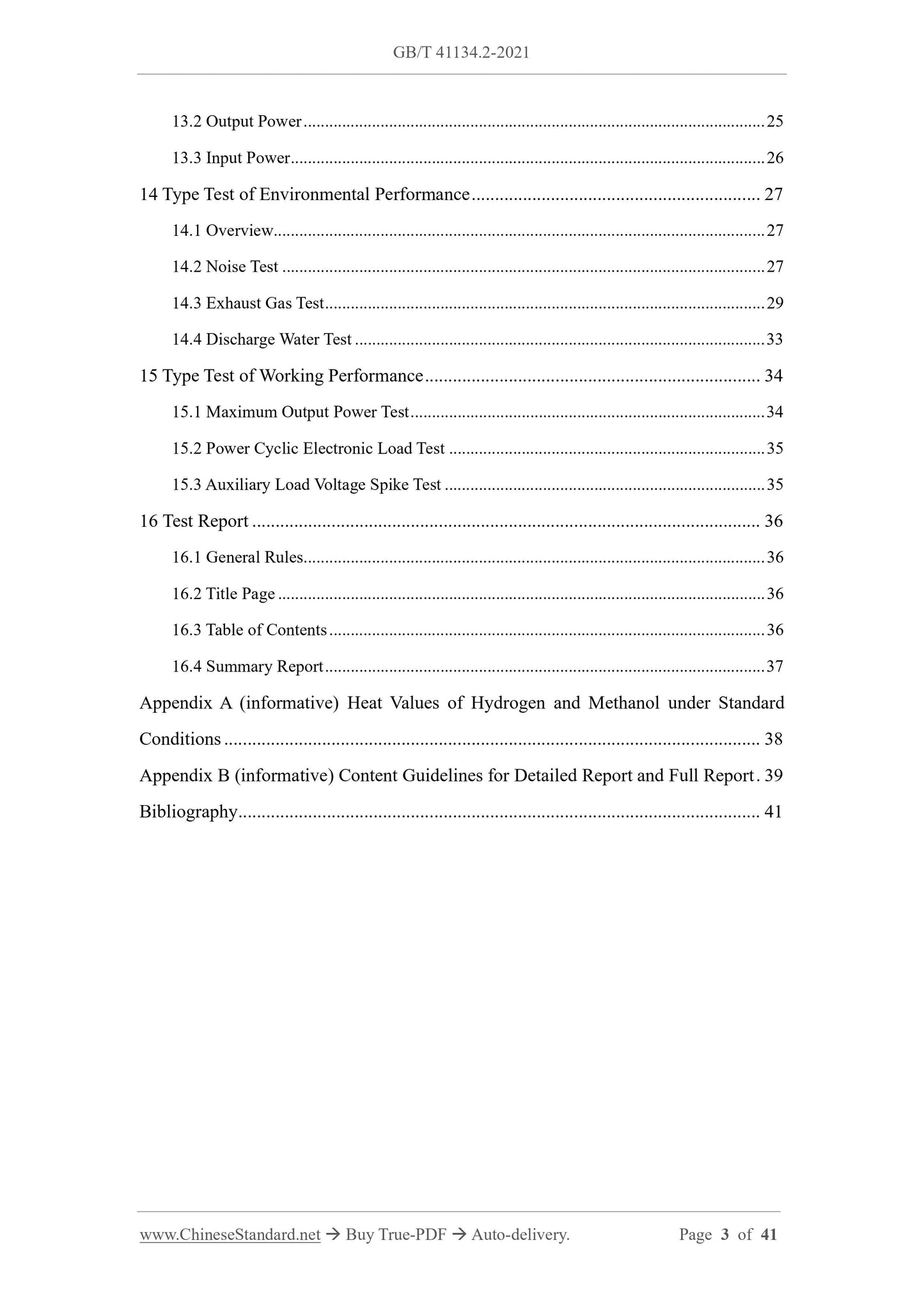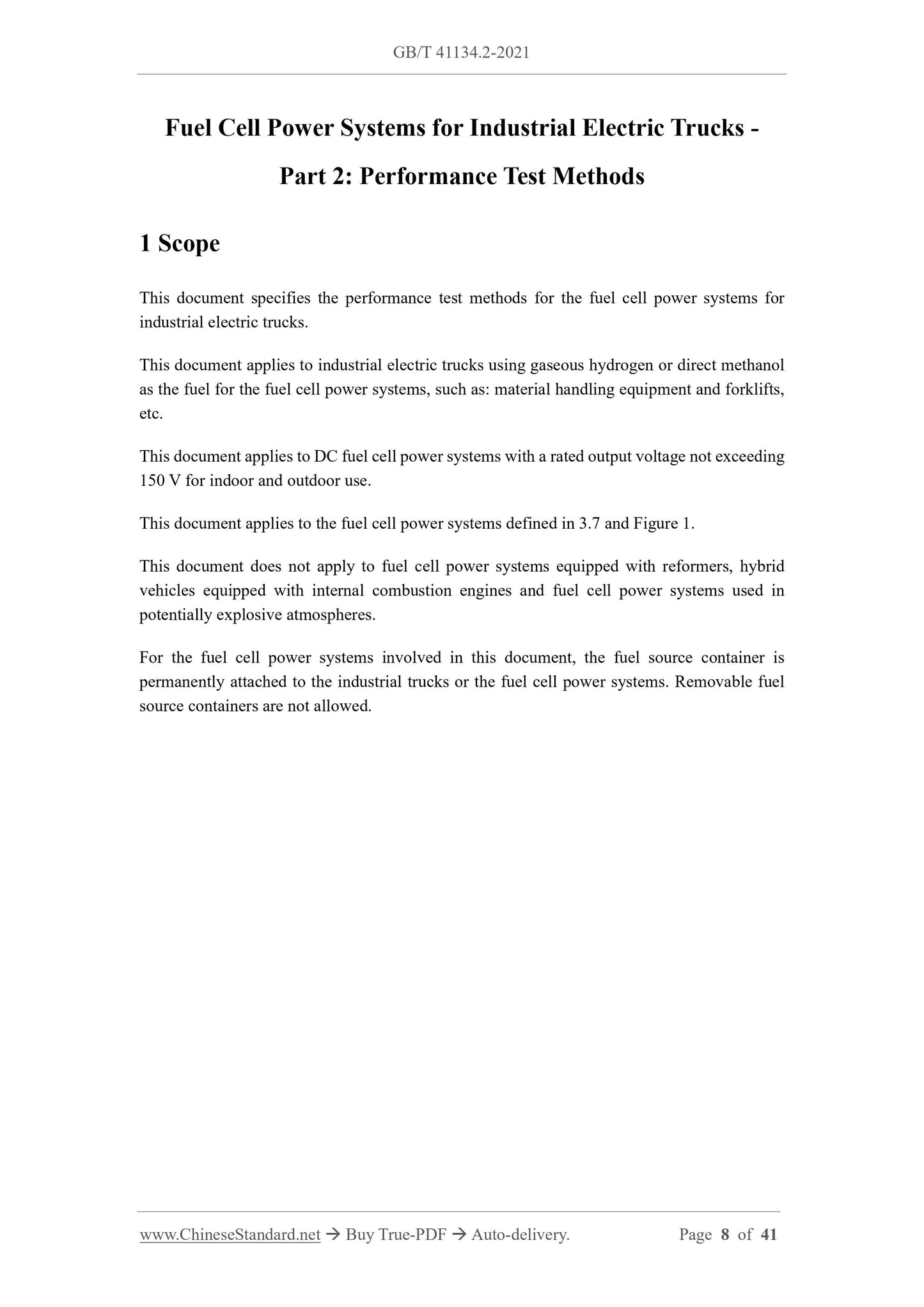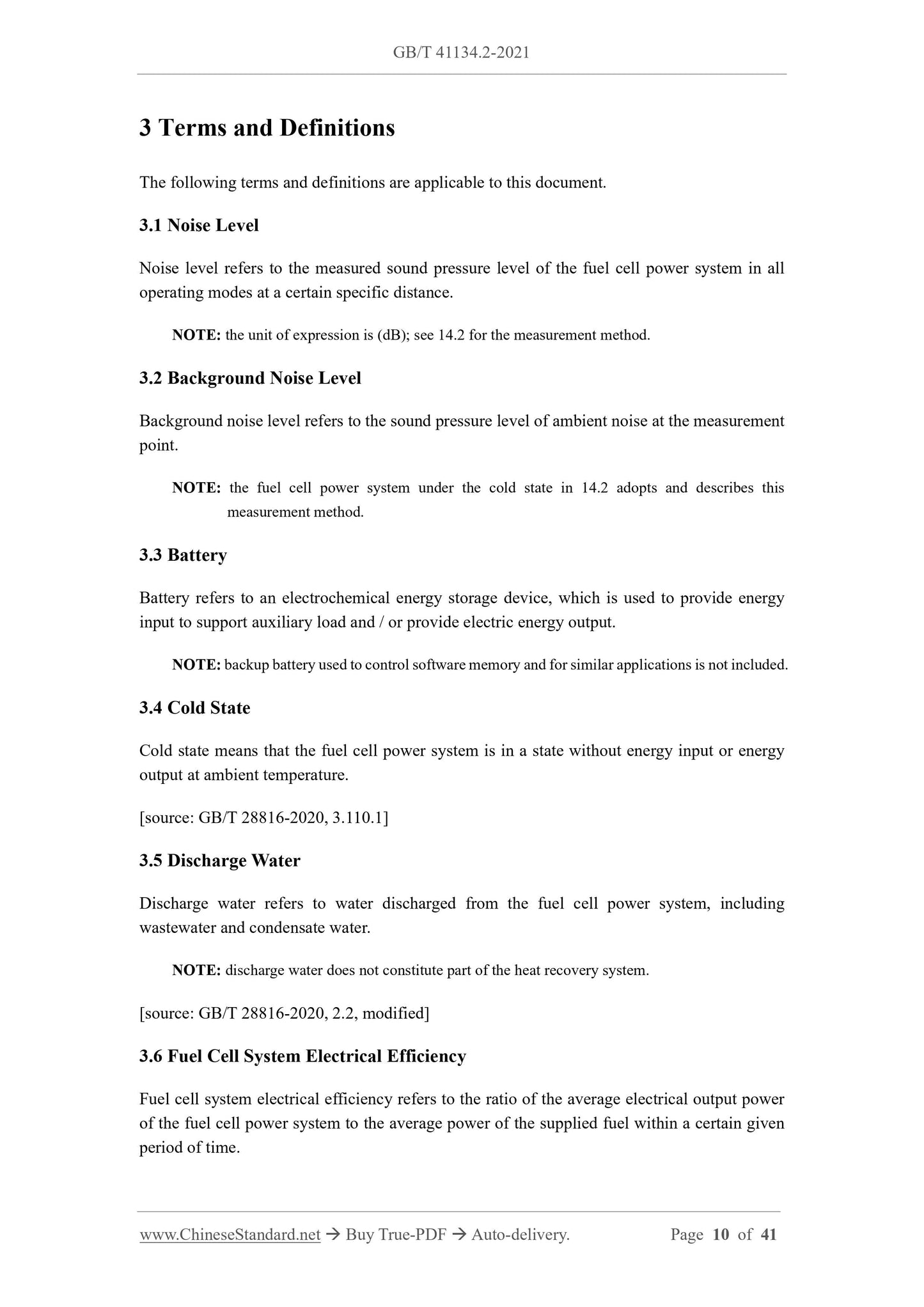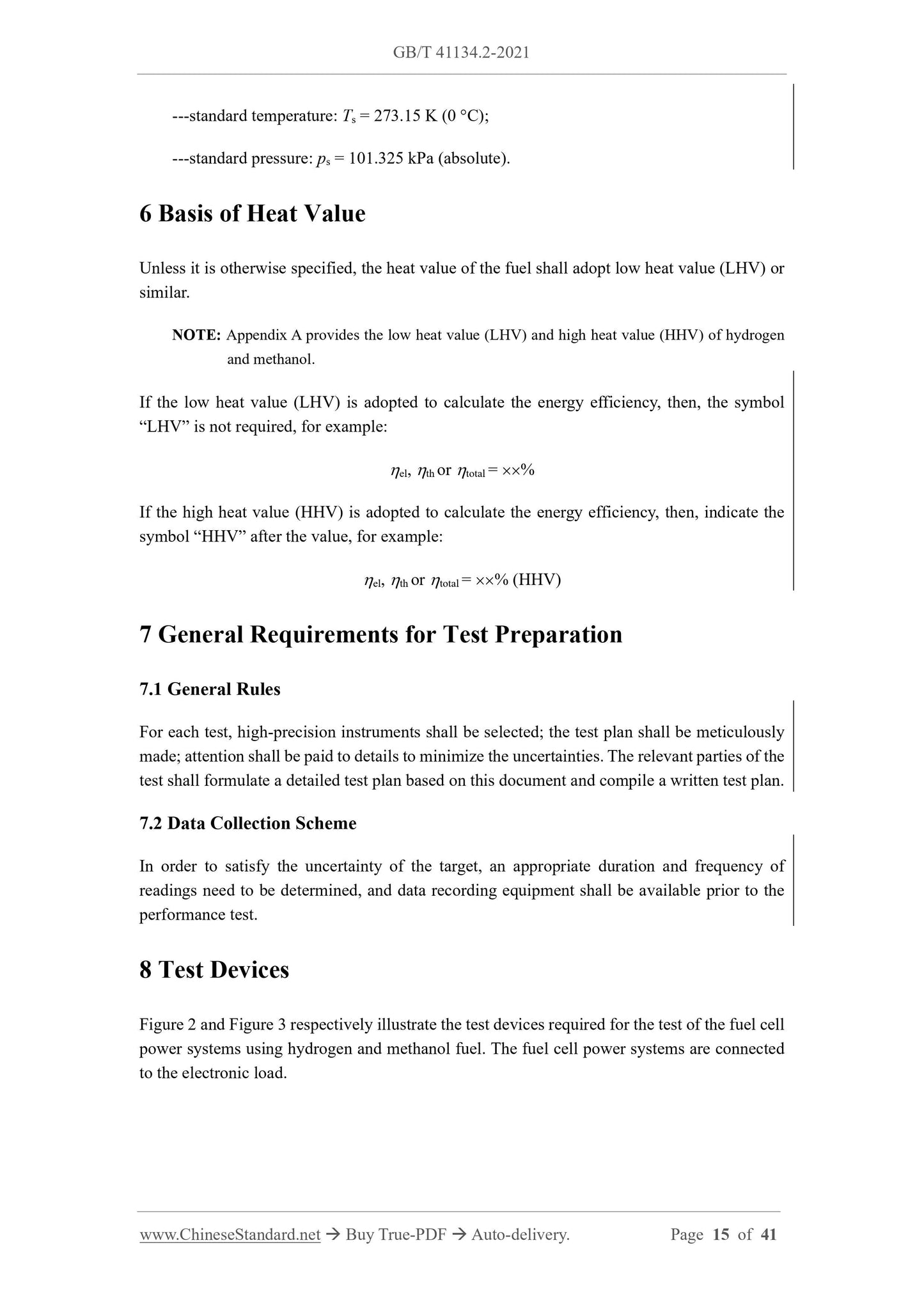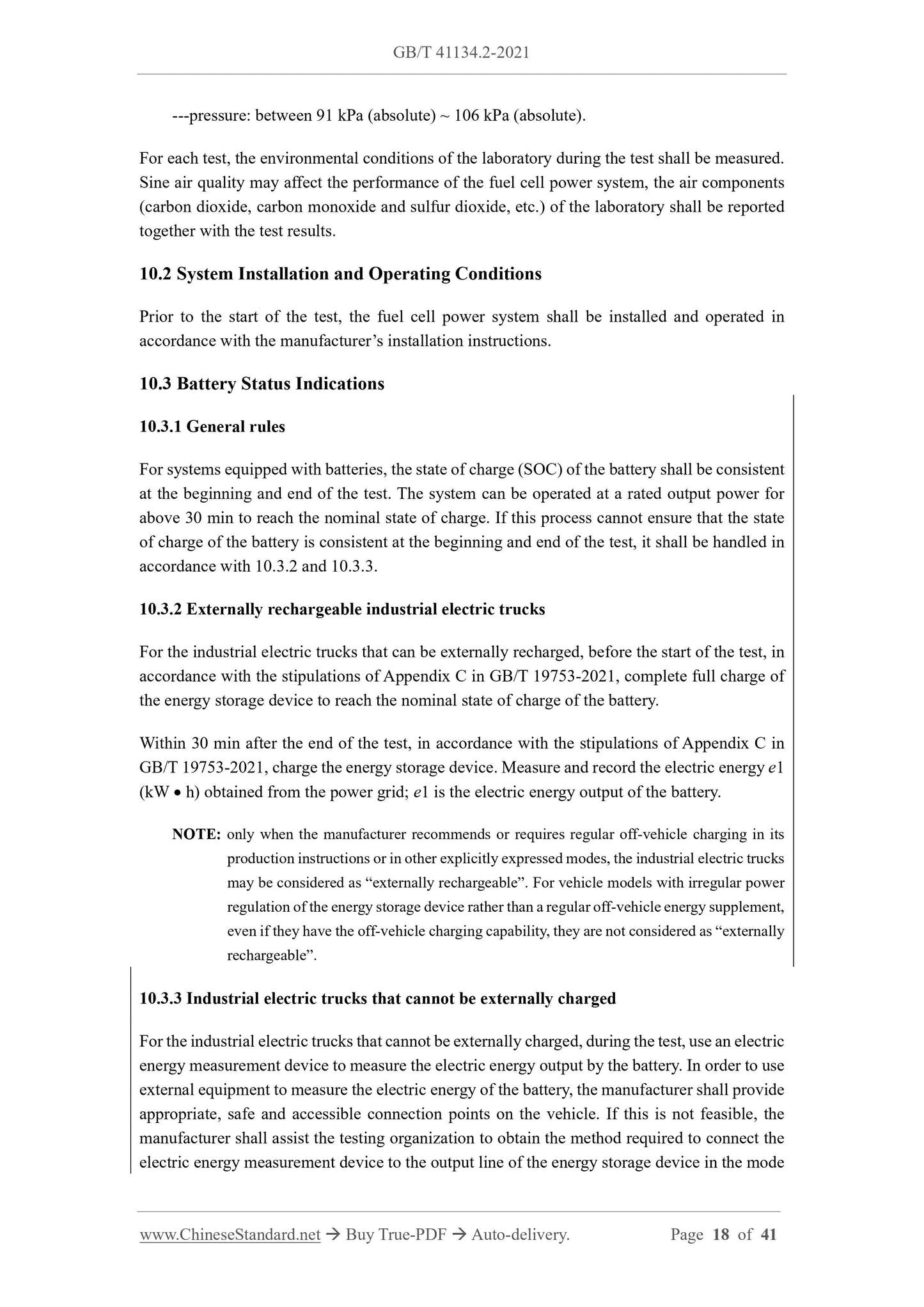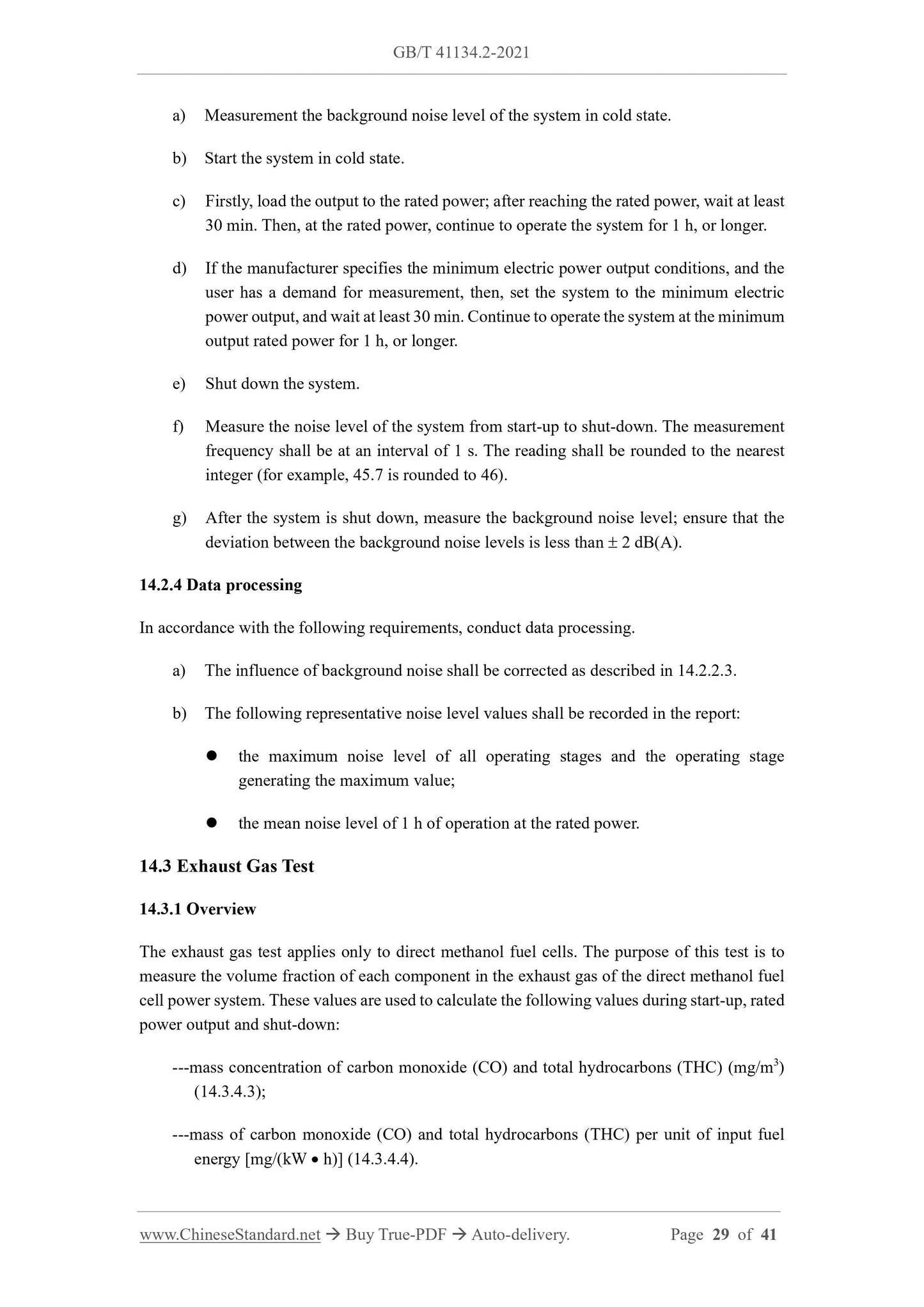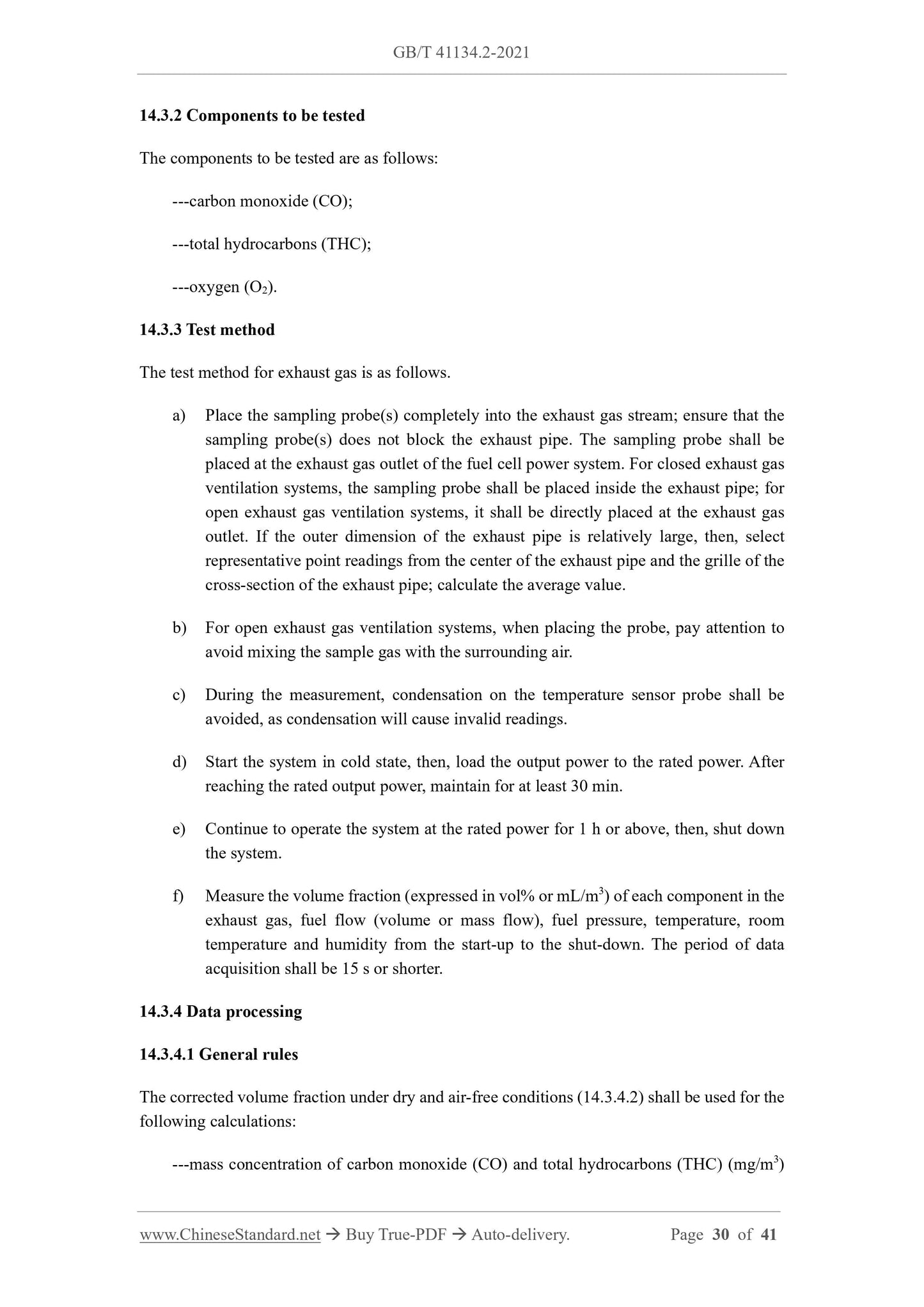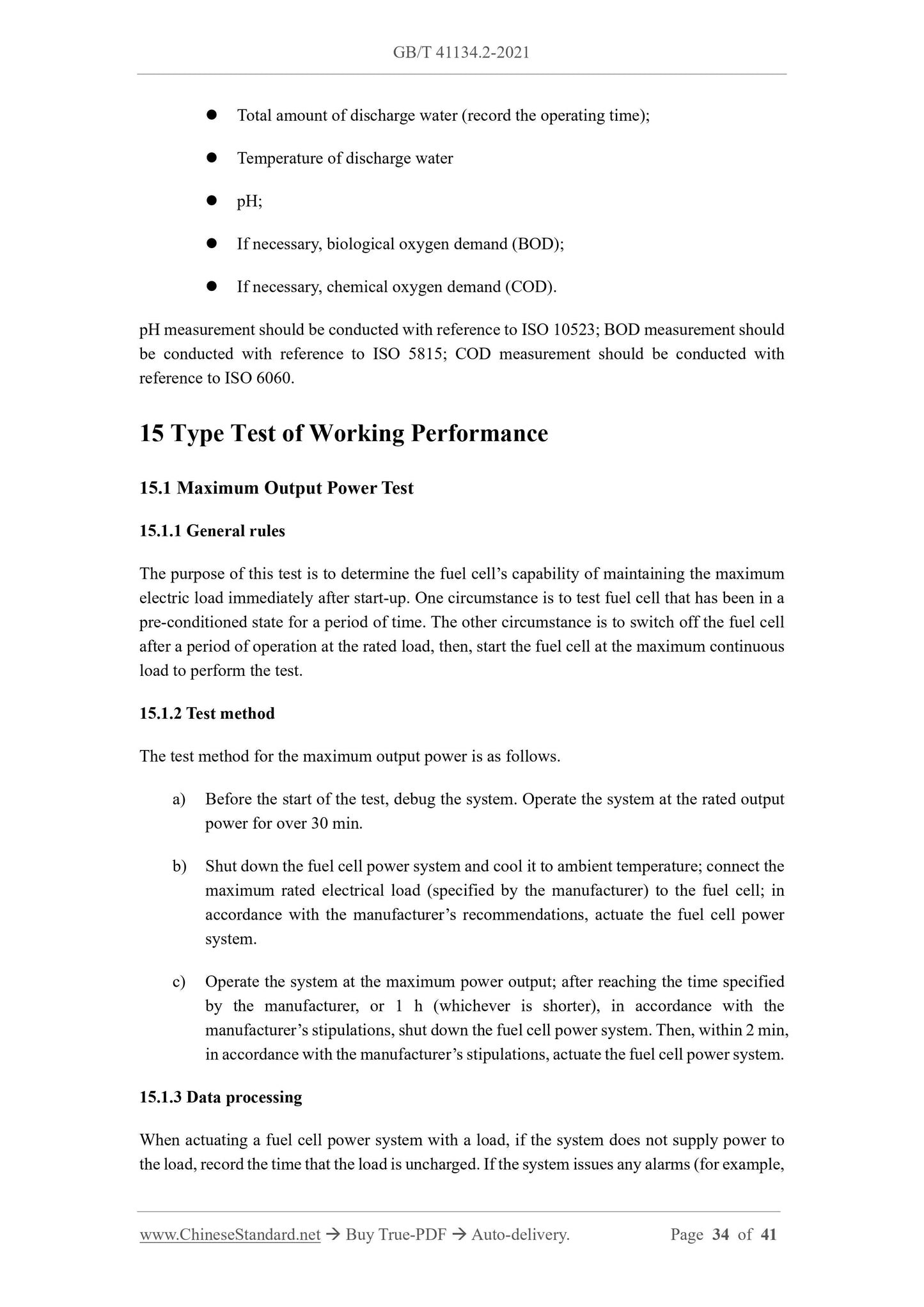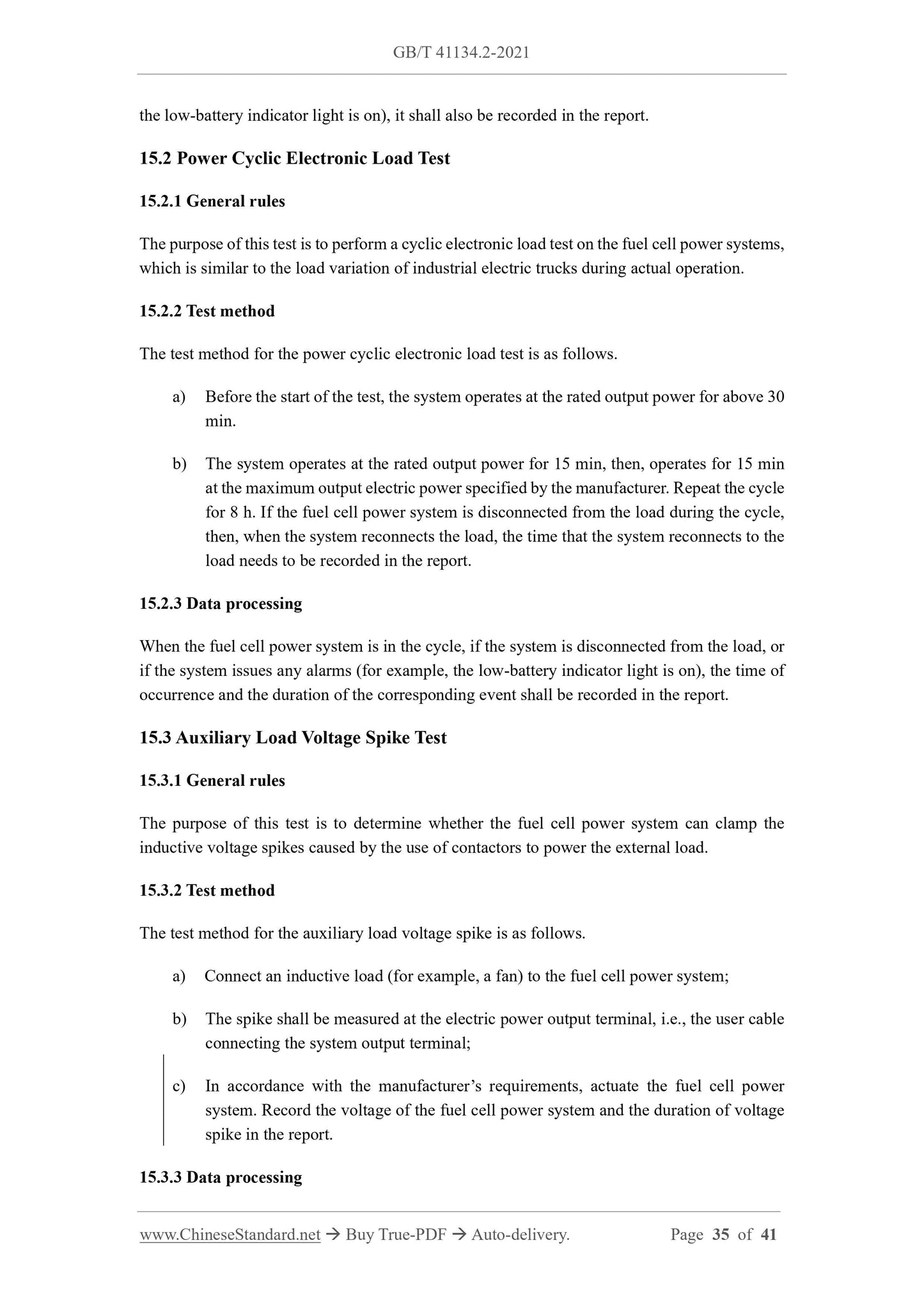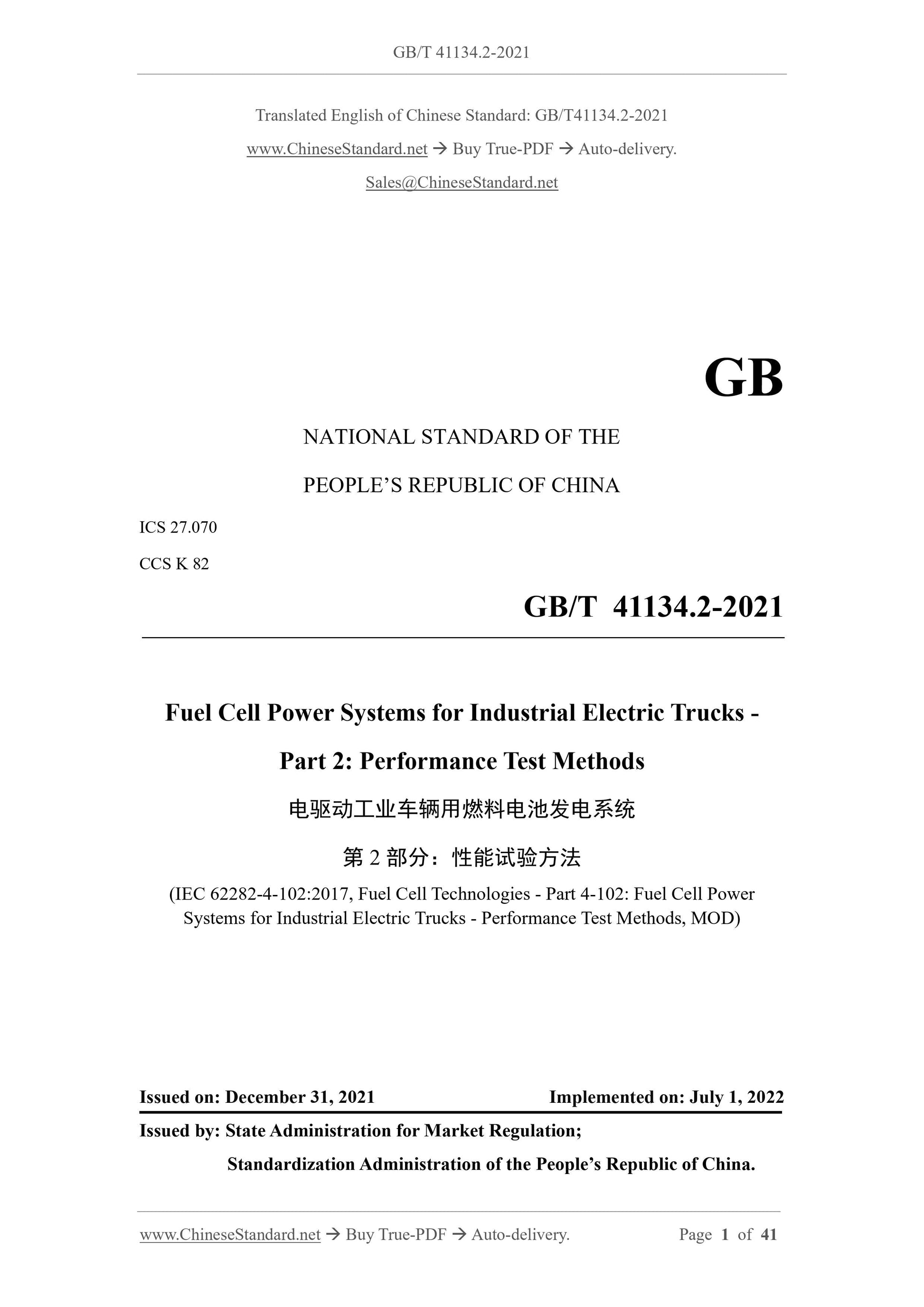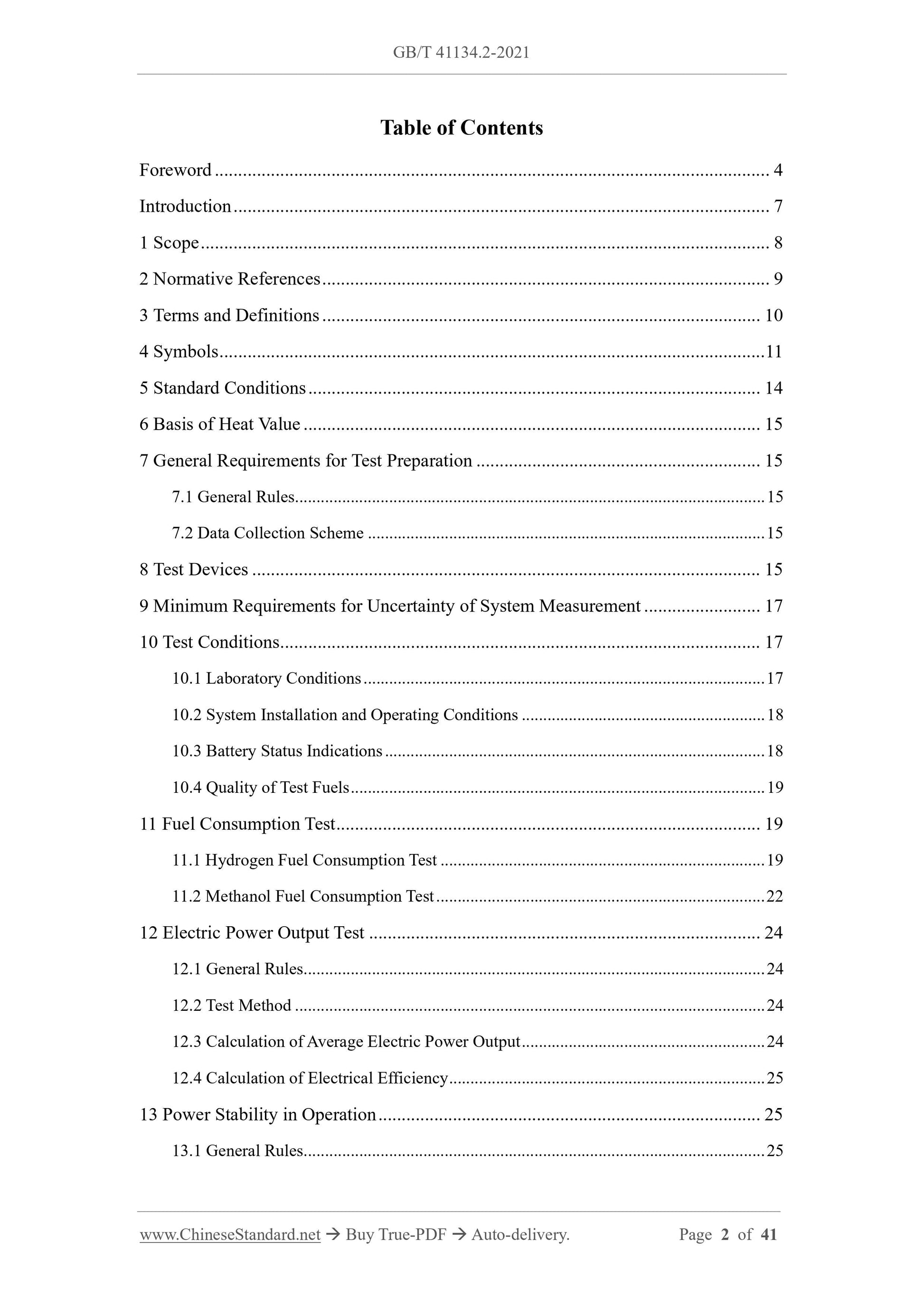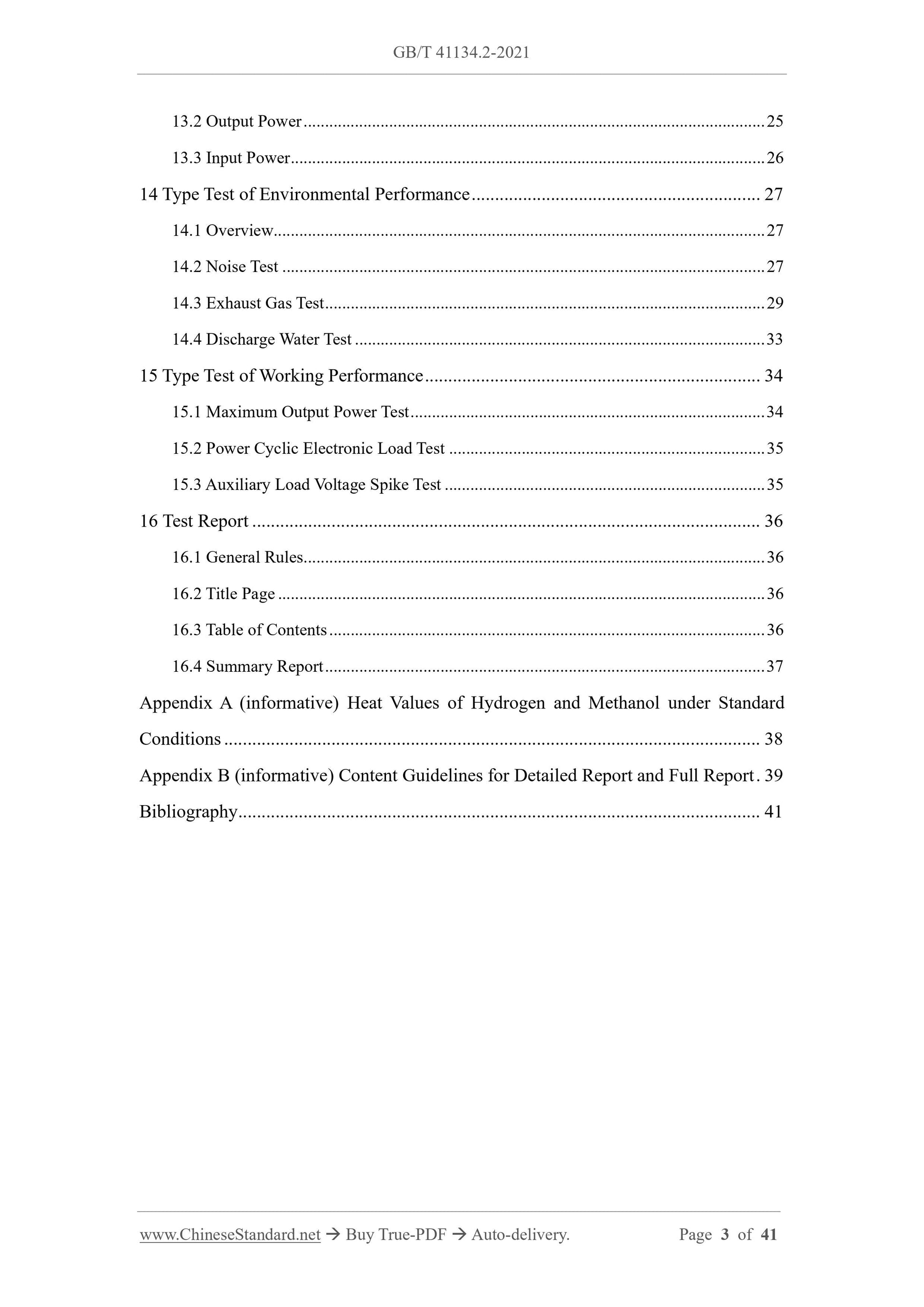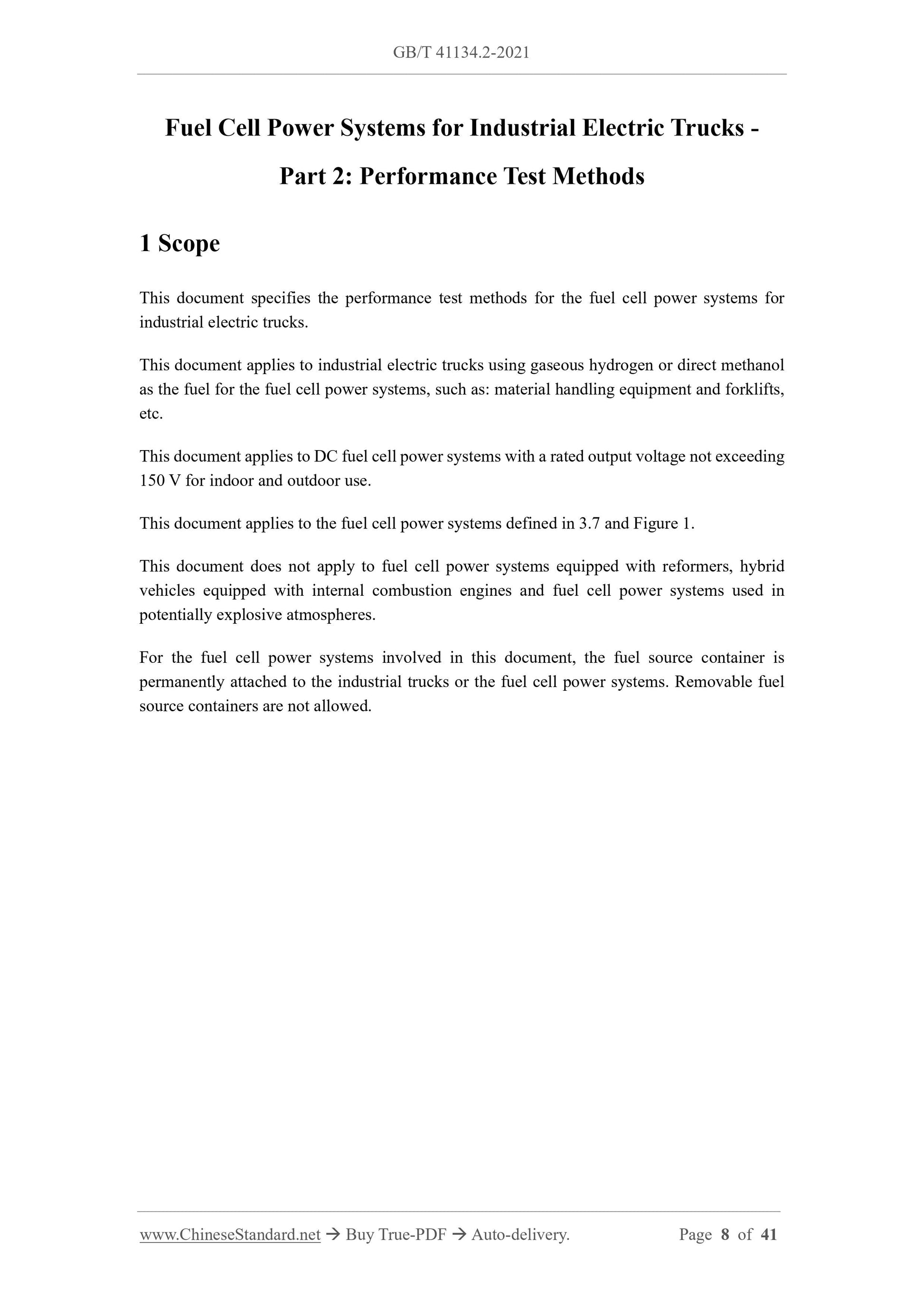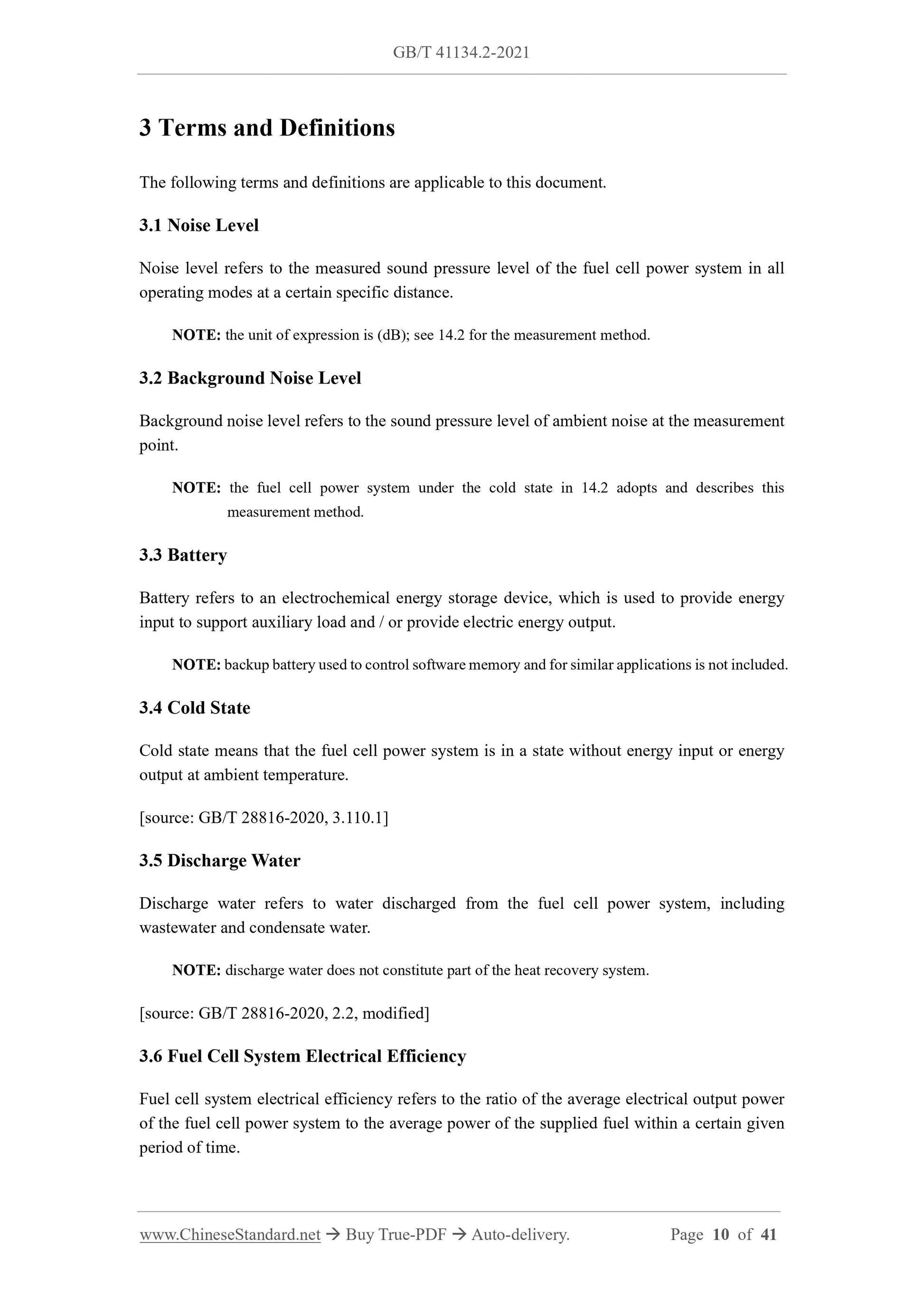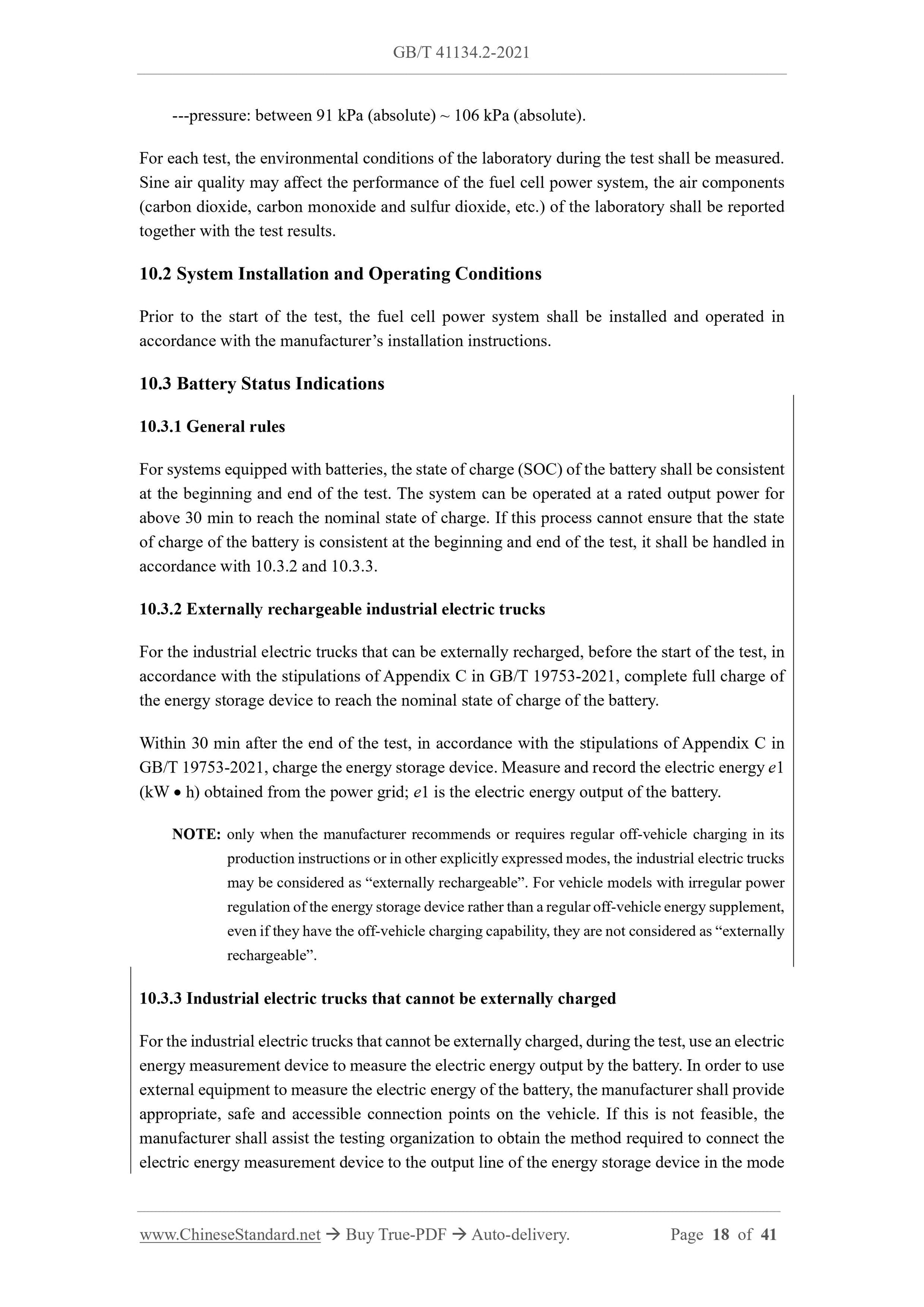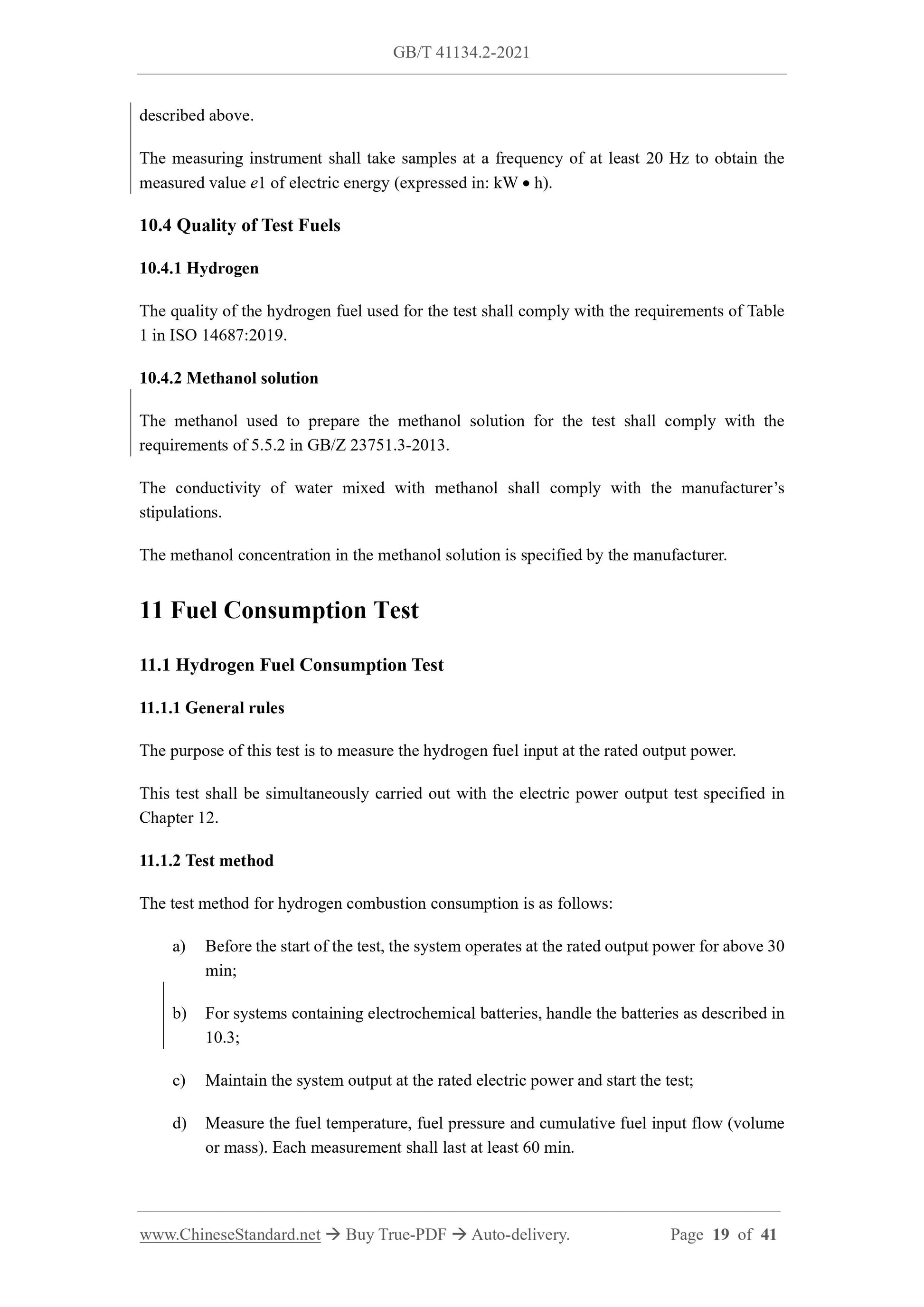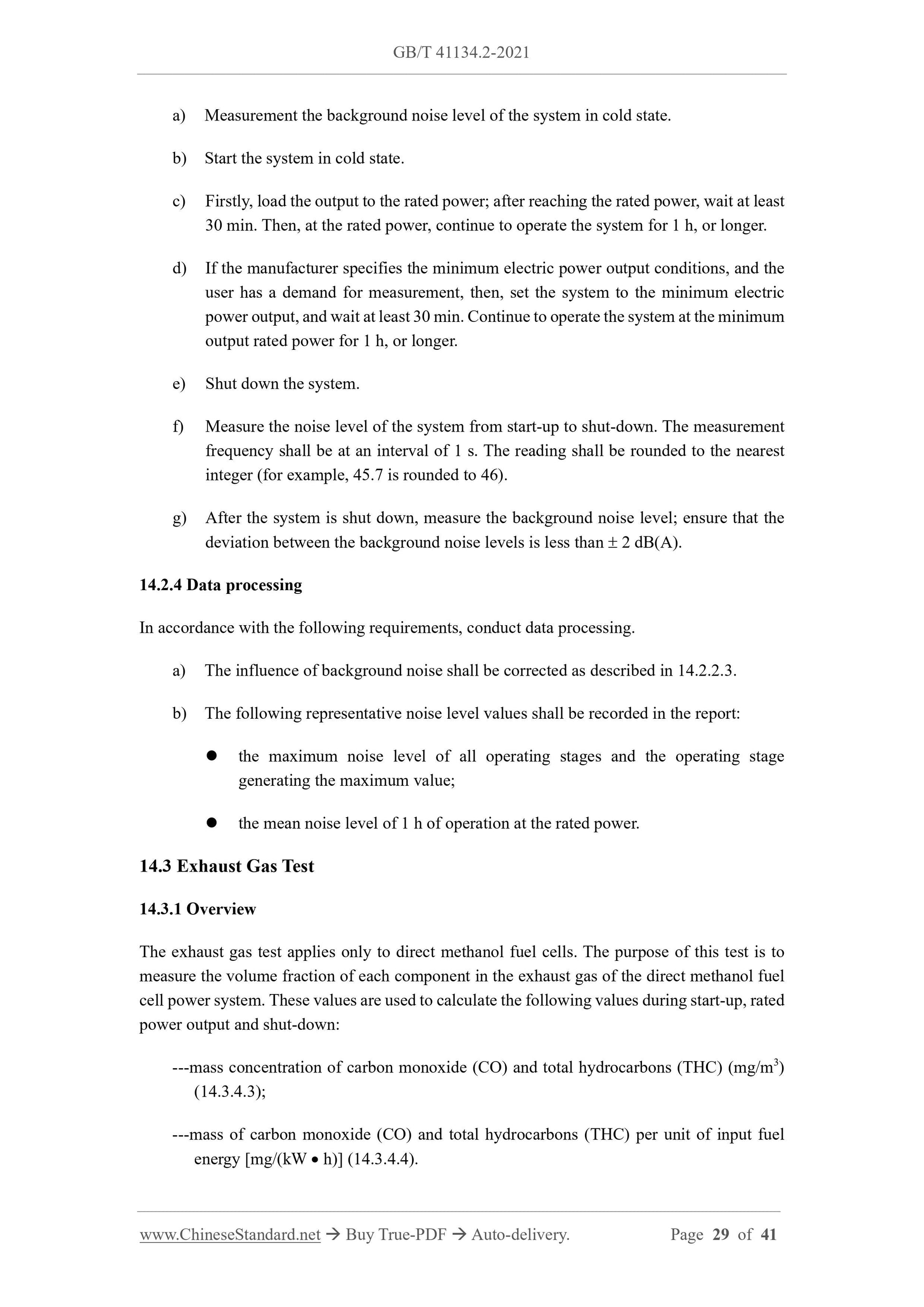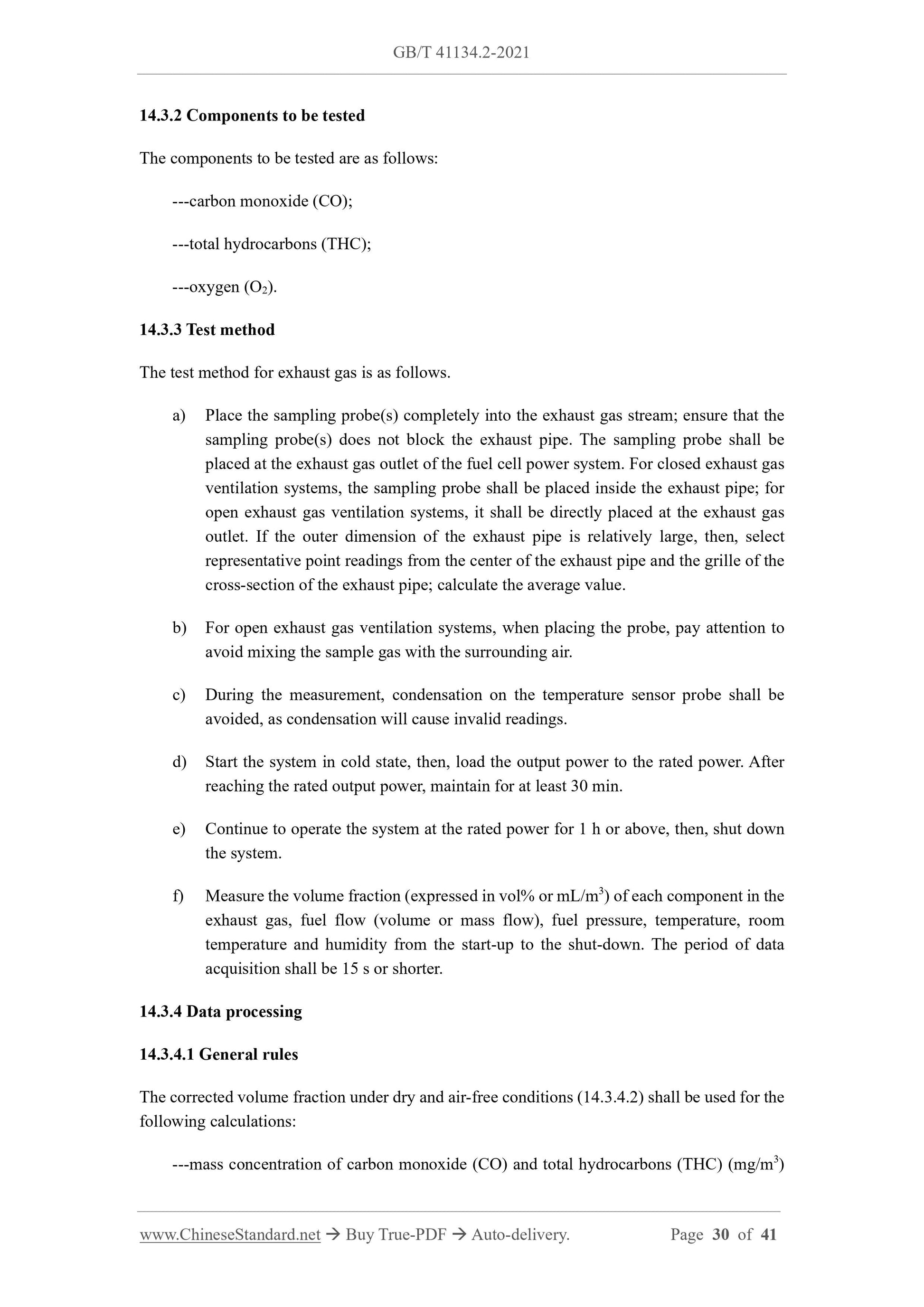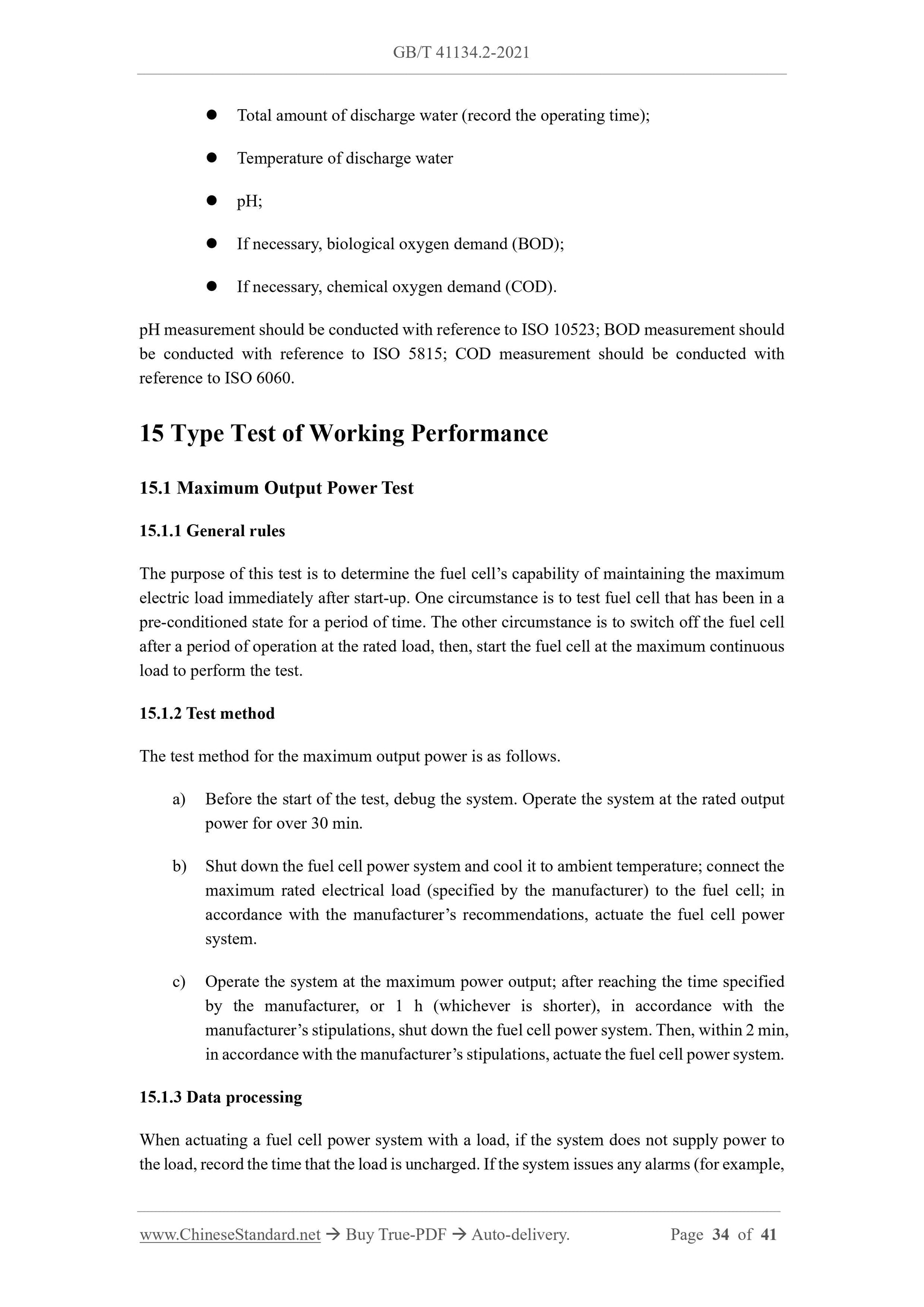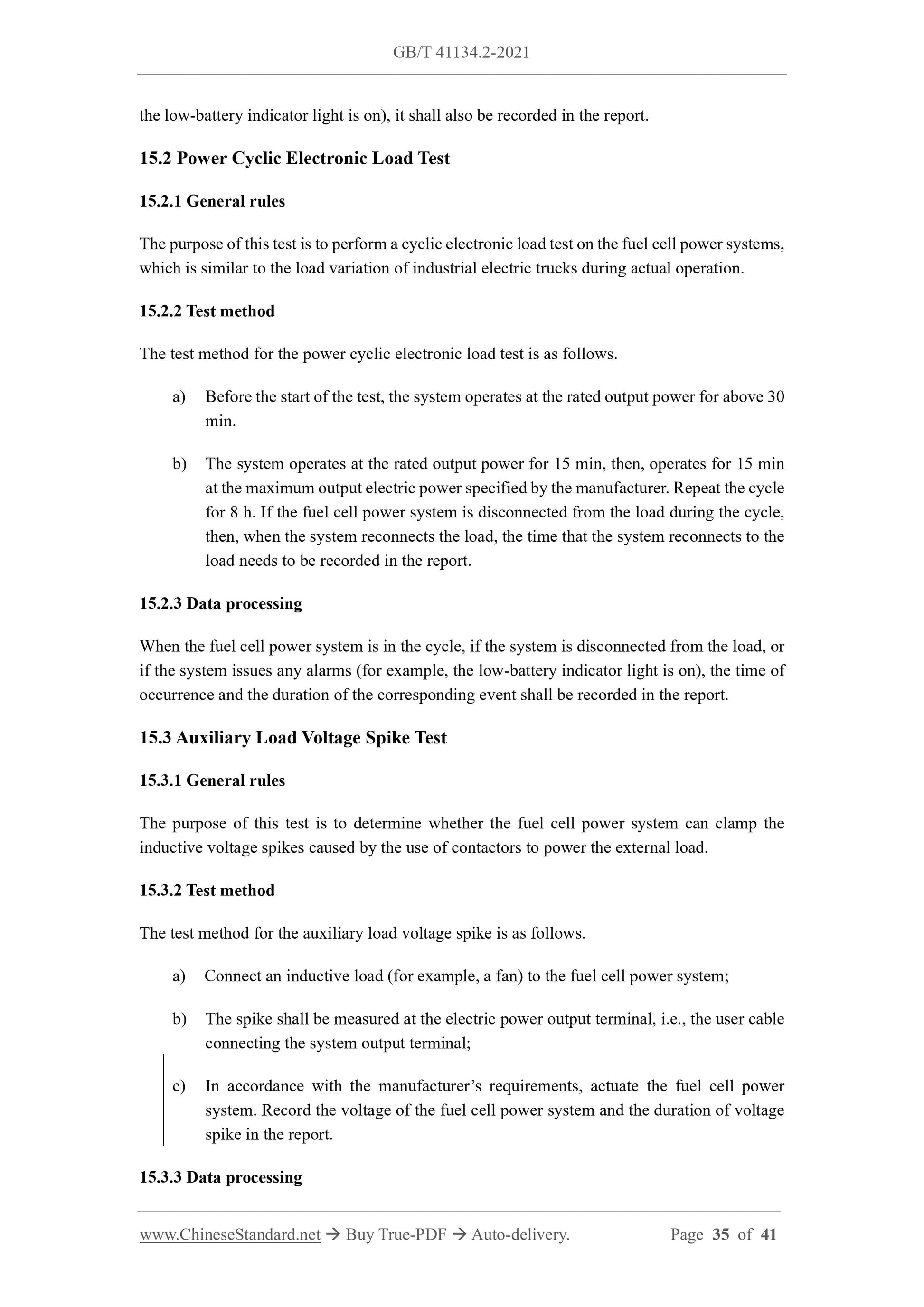1
/
of
12
www.ChineseStandard.us -- Field Test Asia Pte. Ltd.
GB/T 41134.2-2021 English PDF (GB/T41134.2-2021)
GB/T 41134.2-2021 English PDF (GB/T41134.2-2021)
Regular price
$440.00
Regular price
Sale price
$440.00
Unit price
/
per
Shipping calculated at checkout.
Couldn't load pickup availability
GB/T 41134.2-2021: Fuel cell power systems for industrial electric trucks - Part 2: Performance test methods
Delivery: 9 seconds. Download (& Email) true-PDF + Invoice.
Get Quotation: Click GB/T 41134.2-2021 (Self-service in 1-minute)
Historical versions (Master-website): GB/T 41134.2-2021
Preview True-PDF (Reload/Scroll-down if blank)
GB/T 41134.2-2021
NATIONAL STANDARD OF THE
PEOPLE’S REPUBLIC OF CHINA
ICS 27.070
CCS K 82
Fuel Cell Power Systems for Industrial Electric Trucks -
Part 2: Performance Test Methods
(IEC 62282-4-102:2017, Fuel Cell Technologies - Part 4-102: Fuel Cell Power
Systems for Industrial Electric Trucks - Performance Test Methods, MOD)
ISSUED ON: DECEMBER 31, 2021
IMPLEMENTED ON: JULY 1, 2022
Issued by: State Administration for Market Regulation;
Standardization Administration of the People’s Republic of China.
Table of Contents
Foreword ... 4
Introduction ... 7
1 Scope ... 8
2 Normative References ... 9
3 Terms and Definitions ... 10
4 Symbols ... 11
5 Standard Conditions ... 14
6 Basis of Heat Value ... 15
7 General Requirements for Test Preparation ... 15
7.1 General Rules ... 15
7.2 Data Collection Scheme ... 15
8 Test Devices ... 15
9 Minimum Requirements for Uncertainty of System Measurement ... 17
10 Test Conditions ... 17
10.1 Laboratory Conditions ... 17
10.2 System Installation and Operating Conditions ... 18
10.3 Battery Status Indications ... 18
10.4 Quality of Test Fuels ... 19
11 Fuel Consumption Test ... 19
11.1 Hydrogen Fuel Consumption Test ... 19
11.2 Methanol Fuel Consumption Test ... 22
12 Electric Power Output Test ... 24
12.1 General Rules ... 24
12.2 Test Method ... 24
12.3 Calculation of Average Electric Power Output ... 24
12.4 Calculation of Electrical Efficiency ... 25
13 Power Stability in Operation ... 25
13.1 General Rules ... 25
13.2 Output Power ... 25
13.3 Input Power ... 26
14 Type Test of Environmental Performance ... 27
14.1 Overview ... 27
14.2 Noise Test ... 27
14.3 Exhaust Gas Test ... 29
14.4 Discharge Water Test ... 33
15 Type Test of Working Performance ... 34
15.1 Maximum Output Power Test ... 34
15.2 Power Cyclic Electronic Load Test ... 35
15.3 Auxiliary Load Voltage Spike Test ... 35
16 Test Report ... 36
16.1 General Rules ... 36
16.2 Title Page ... 36
16.3 Table of Contents ... 36
16.4 Summary Report ... 37
Appendix A (informative) Heat Values of Hydrogen and Methanol under Standard
Conditions ... 38
Appendix B (informative) Content Guidelines for Detailed Report and Full Report . 39
Bibliography ... 41
Fuel Cell Power Systems for Industrial Electric Trucks -
Part 2: Performance Test Methods
1 Scope
This document specifies the performance test methods for the fuel cell power systems for
industrial electric trucks.
This document applies to industrial electric trucks using gaseous hydrogen or direct methanol
as the fuel for the fuel cell power systems, such as: material handling equipment and forklifts,
etc.
This document applies to DC fuel cell power systems with a rated output voltage not exceeding
150 V for indoor and outdoor use.
This document applies to the fuel cell power systems defined in 3.7 and Figure 1.
This document does not apply to fuel cell power systems equipped with reformers, hybrid
vehicles equipped with internal combustion engines and fuel cell power systems used in
potentially explosive atmospheres.
For the fuel cell power systems involved in this document, the fuel source container is
permanently attached to the industrial trucks or the fuel cell power systems. Removable fuel
source containers are not allowed.
3 Terms and Definitions
The following terms and definitions are applicable to this document.
3.1 Noise Level
Noise level refers to the measured sound pressure level of the fuel cell power system in all
operating modes at a certain specific distance.
NOTE: the unit of expression is (dB); see 14.2 for the measurement method.
3.2 Background Noise Level
Background noise level refers to the sound pressure level of ambient noise at the measurement
point.
NOTE: the fuel cell power system under the cold state in 14.2 adopts and describes this
measurement method.
3.3 Battery
Battery refers to an electrochemical energy storage device, which is used to provide energy
input to support auxiliary load and / or provide electric energy output.
NOTE: backup battery used to control software memory and for similar applications is not included.
3.4 Cold State
Cold state means that the fuel cell power system is in a state without energy input or energy
output at ambient temperature.
[source: GB/T 28816-2020, 3.110.1]
3.5 Discharge Water
Discharge water refers to water discharged from the fuel cell power system, including
wastewater and condensate water.
NOTE: discharge water does not constitute part of the heat recovery system.
[source: GB/T 28816-2020, 2.2, modified]
3.6 Fuel Cell System Electrical Efficiency
Fuel cell system electrical efficiency refers to the ratio of the average electrical output power
of the fuel cell power system to the average power of the supplied fuel within a certain given
period of time.
---standard temperature: Ts = 273.15 K (0 C);
---standard pressure: ps = 101.325 kPa (absolute).
6 Basis of Heat Value
Unless it is otherwise specified, the heat value of the fuel shall adopt low heat value (LHV) or
similar.
NOTE: Appendix A provides the low heat value (LHV) and high heat value (HHV) of hydrogen
and methanol.
If the low heat value (LHV) is adopted to calculate the energy efficiency, then, the symbol
“LHV” is not required, for example:
el, th or total = %
If the high heat value (HHV) is adopted to calculate the energy efficiency, then, indicate the
symbol “HHV” after the value, for example:
el, th or total = % (HHV)
7 General Requirements for Test Preparation
7.1 General Rules
For each test, high-precision instruments shall be selected; the test plan shall be meticulously
made; attention shall be paid to details to minimize the uncertainties. The relevant parties of the
test shall formulate a detailed test plan based on this document and compile a written test plan.
7.2 Data Collection Scheme
In order to satisfy the uncertainty of the target, an appropriate duration and frequency of
readings need to be determined, and data recording equipment shall be available prior to the
performance test.
8 Test Devices
Figure 2 and Figure 3 respectively illustrate the test devices required for the test of the fuel cell
power systems using hydrogen and methanol fuel. The fuel cell power systems are connected
to the electronic load.
---pressure: between 91 kPa (absolute) ~ 106 kPa (absolute).
For each test, the environmental conditions of the laboratory during the test shall be measured.
Sine air quality may affect the performance of the fuel cell power system, the air components
(carbon dioxide, carbon monoxide and sulfur dioxide, etc.) of the laboratory shall be reported
together with the test results.
10.2 System Installation and Operating Conditions
Prior to the start of the test, the fuel cell power system shall be installed and operated in
accordance with the manufacturer’s installation instructions.
10.3 Battery Status Indications
10.3.1 General rules
For systems equipped with batteries, the state of charge (SOC) of the battery shall be consistent
at the beginning and end of the test. The system can be operated at a rated output power for
above 30 min to reach the nominal state of charge. If this process cannot ensure that the state
of charge of the battery is consistent at the beginning and end of the test, it shall be handled in
accordance with 10.3.2 and 10.3.3.
10.3.2 Externally rechargeable industrial electric trucks
For the industrial electric trucks that can be externally recharged, before the start of the test, in
accordance with the stipulations of Appendix C in GB/T 19753-2021, complete full charge of
the energy storage device to reach the nominal state of charge of the battery.
Within 30 min after the end of the test, in accordance with the stipulations of Appendix C in
GB/T 19753-2021, charge the energy storage device. Measure and record the electric energy e1
(kW h) obtained from the power grid; e1 is the electric energy output of the battery.
NOTE: only when the manufacturer recommends or requires regular off-vehicle charging in its
production instructions or in other explicitly expressed modes, the industrial electric trucks
may be considered as “externally rechargeable”. For vehicle models with irregular power
regulation of the energy storage device rather than a regular off-vehicle energy supplement,
even if they have the off-vehicle charging capability, they are not considered as “externally
rechargeable”.
10.3.3 Industrial electric trucks that cannot be externally charged
For the industrial electric trucks that cannot be externally charged, during the test, use an electric
energy measurement device to measure the electric energy output by the battery. In order to use
external equipment to measure the electric energy of the battery, the manufacturer shall provide
appropriate, safe and accessible connection points on the vehicle. If this is not feasible, the
manufacturer shall assist the testing organization to obtain the method required to connect the
electric energy measurement device to the output line of the energy storage device in the mode
described above.
The measuring instrument shall take samples at a frequency of at least 20 Hz to obtain the
measured value e1 of electric energy (expressed in: kW h).
10.4 Quality of Test Fuels
10.4.1 Hydrogen
The quality of the hydrogen fuel used for the test shall comply with the requirements of Table
1 in ISO 14687:2019.
10.4.2 Methanol solution
The methanol used to prepare the methanol solution for the test shall comply with the
requirements of 5.5.2 in GB/Z 23751.3-2013.
The conductivity of water mixed with methanol shall comply with the manufacturer’s
stipulations.
The methanol concentration in the methanol solution is specified by the manufacturer.
11 Fuel Consumption Test
11.1 Hydrogen Fuel Consumption Test
11.1.1 General rules
The purpose of this test is to measure the hydrogen fuel input at the rated output power.
This test shall be simultaneously carried out with the electric power output test specified in
Chapter 12.
11.1.2 Test method
The test method for hydrogen combustion consumption is as follows:
a) Before the start of the test, the system operates at the rated output power for above 30
min;
b) For systems containing electrochemical batteries, handle the batteries as described in
10.3;
c) Maintain the system output at the rated electric power and start the test;
d) Measure the fuel temperature, fuel pressure and cumulative fuel input flow (volume
or mass). Each measurement shall last at least 60 min.
a) Measurement the background noise level of the system in cold state.
b) Start the system in cold state.
c) Firstly, load the output to the rated power; after reaching the rated power, wait at least
30 min. Then, at the rated power, continue to operate the system for 1 h, or longer.
d) If the manufacturer specifies the minimum electric power output conditions, and the
user has a demand for measurement, then, set the system to the minimum electric
power output, and wait at least 30 min. Continue to operate the system at the minimum
output rated power for 1 h, or longer.
e) Shut down the system.
f) Measure the noise level of the system from start-up to shut-down. The measurement
frequency shall be at an interval of 1 s. The reading shall be rounded to the nearest
integer (for example, 45.7 is rounded to 46).
g) After the system is shut down, measure the background noise level; ensure that the
deviation between the background noise levels is less than 2 dB(A).
14.2.4 Data processing
In accordance with the following requirements, conduct data processing.
a) The influence of background noise shall be corrected as described in 14.2.2.3.
b) The following representative noise level values shall be recorded in the report:
the maximum noise level of all operating stages and the operating stage
generating the maximum value;
the mean noise level of 1 h of operation at the rated power.
14.3 Exhaust Gas Test
14.3.1 Overview
The exhaust gas test applies only to direct methanol fuel cells. The purpose of this test is to
measure the volume fraction of each component in the exhaust gas of the direct methanol fuel
cell power system. These values are used to calculate the following values during start-up, rated
power output and shut-down:
---mass concentration of carbon monoxide (CO) and total hydrocarbons (THC) (mg/m3)
(14.3.4.3);
---mass of carbon monoxide (CO) and total hydrocarbons (THC) per unit of input fuel
energy [mg/(kW h)] (14.3.4.4).
14.3.2 Components to be tested
The components to be tested are as follows:
---carbon monoxide (CO);
---total hydrocarbons (THC);
---oxygen (O2).
14.3.3 Test method
The test method for exhaust gas is as follows.
a) Place the sampling probe(s) completely into the exhaust gas stream; ensure that the
sampling probe(s) does not block the exhaust pipe. The sampling probe shall be
placed at the exhaust gas outlet of the fuel cell power system. For closed exhaust gas
ventilation systems, the sampling probe shall be placed inside the exhaust pipe; for
open exhaust gas ventilation systems, it shall be directly placed at the exhaust gas
outlet. If the outer dimension of the exhaust pipe is relatively large, then, select
representative point readings from the center of the exhaust pipe and the grille of the
cross-section of the exhaust pipe; calculate the average value.
b) For open exhaust gas ventilation systems, when placing the probe, pay attention to
avoid mixing the sample gas with the surrounding air.
c) During the measurement, condensation on the temperature sensor probe shall be
avoided, as condensation will cause invalid readings.
d) Start the system in cold state, then, load the output power to the rated power. After
reaching the rated output power, maintain for at least 30 min. <...
Delivery: 9 seconds. Download (& Email) true-PDF + Invoice.
Get Quotation: Click GB/T 41134.2-2021 (Self-service in 1-minute)
Historical versions (Master-website): GB/T 41134.2-2021
Preview True-PDF (Reload/Scroll-down if blank)
GB/T 41134.2-2021
NATIONAL STANDARD OF THE
PEOPLE’S REPUBLIC OF CHINA
ICS 27.070
CCS K 82
Fuel Cell Power Systems for Industrial Electric Trucks -
Part 2: Performance Test Methods
(IEC 62282-4-102:2017, Fuel Cell Technologies - Part 4-102: Fuel Cell Power
Systems for Industrial Electric Trucks - Performance Test Methods, MOD)
ISSUED ON: DECEMBER 31, 2021
IMPLEMENTED ON: JULY 1, 2022
Issued by: State Administration for Market Regulation;
Standardization Administration of the People’s Republic of China.
Table of Contents
Foreword ... 4
Introduction ... 7
1 Scope ... 8
2 Normative References ... 9
3 Terms and Definitions ... 10
4 Symbols ... 11
5 Standard Conditions ... 14
6 Basis of Heat Value ... 15
7 General Requirements for Test Preparation ... 15
7.1 General Rules ... 15
7.2 Data Collection Scheme ... 15
8 Test Devices ... 15
9 Minimum Requirements for Uncertainty of System Measurement ... 17
10 Test Conditions ... 17
10.1 Laboratory Conditions ... 17
10.2 System Installation and Operating Conditions ... 18
10.3 Battery Status Indications ... 18
10.4 Quality of Test Fuels ... 19
11 Fuel Consumption Test ... 19
11.1 Hydrogen Fuel Consumption Test ... 19
11.2 Methanol Fuel Consumption Test ... 22
12 Electric Power Output Test ... 24
12.1 General Rules ... 24
12.2 Test Method ... 24
12.3 Calculation of Average Electric Power Output ... 24
12.4 Calculation of Electrical Efficiency ... 25
13 Power Stability in Operation ... 25
13.1 General Rules ... 25
13.2 Output Power ... 25
13.3 Input Power ... 26
14 Type Test of Environmental Performance ... 27
14.1 Overview ... 27
14.2 Noise Test ... 27
14.3 Exhaust Gas Test ... 29
14.4 Discharge Water Test ... 33
15 Type Test of Working Performance ... 34
15.1 Maximum Output Power Test ... 34
15.2 Power Cyclic Electronic Load Test ... 35
15.3 Auxiliary Load Voltage Spike Test ... 35
16 Test Report ... 36
16.1 General Rules ... 36
16.2 Title Page ... 36
16.3 Table of Contents ... 36
16.4 Summary Report ... 37
Appendix A (informative) Heat Values of Hydrogen and Methanol under Standard
Conditions ... 38
Appendix B (informative) Content Guidelines for Detailed Report and Full Report . 39
Bibliography ... 41
Fuel Cell Power Systems for Industrial Electric Trucks -
Part 2: Performance Test Methods
1 Scope
This document specifies the performance test methods for the fuel cell power systems for
industrial electric trucks.
This document applies to industrial electric trucks using gaseous hydrogen or direct methanol
as the fuel for the fuel cell power systems, such as: material handling equipment and forklifts,
etc.
This document applies to DC fuel cell power systems with a rated output voltage not exceeding
150 V for indoor and outdoor use.
This document applies to the fuel cell power systems defined in 3.7 and Figure 1.
This document does not apply to fuel cell power systems equipped with reformers, hybrid
vehicles equipped with internal combustion engines and fuel cell power systems used in
potentially explosive atmospheres.
For the fuel cell power systems involved in this document, the fuel source container is
permanently attached to the industrial trucks or the fuel cell power systems. Removable fuel
source containers are not allowed.
3 Terms and Definitions
The following terms and definitions are applicable to this document.
3.1 Noise Level
Noise level refers to the measured sound pressure level of the fuel cell power system in all
operating modes at a certain specific distance.
NOTE: the unit of expression is (dB); see 14.2 for the measurement method.
3.2 Background Noise Level
Background noise level refers to the sound pressure level of ambient noise at the measurement
point.
NOTE: the fuel cell power system under the cold state in 14.2 adopts and describes this
measurement method.
3.3 Battery
Battery refers to an electrochemical energy storage device, which is used to provide energy
input to support auxiliary load and / or provide electric energy output.
NOTE: backup battery used to control software memory and for similar applications is not included.
3.4 Cold State
Cold state means that the fuel cell power system is in a state without energy input or energy
output at ambient temperature.
[source: GB/T 28816-2020, 3.110.1]
3.5 Discharge Water
Discharge water refers to water discharged from the fuel cell power system, including
wastewater and condensate water.
NOTE: discharge water does not constitute part of the heat recovery system.
[source: GB/T 28816-2020, 2.2, modified]
3.6 Fuel Cell System Electrical Efficiency
Fuel cell system electrical efficiency refers to the ratio of the average electrical output power
of the fuel cell power system to the average power of the supplied fuel within a certain given
period of time.
---standard temperature: Ts = 273.15 K (0 C);
---standard pressure: ps = 101.325 kPa (absolute).
6 Basis of Heat Value
Unless it is otherwise specified, the heat value of the fuel shall adopt low heat value (LHV) or
similar.
NOTE: Appendix A provides the low heat value (LHV) and high heat value (HHV) of hydrogen
and methanol.
If the low heat value (LHV) is adopted to calculate the energy efficiency, then, the symbol
“LHV” is not required, for example:
el, th or total = %
If the high heat value (HHV) is adopted to calculate the energy efficiency, then, indicate the
symbol “HHV” after the value, for example:
el, th or total = % (HHV)
7 General Requirements for Test Preparation
7.1 General Rules
For each test, high-precision instruments shall be selected; the test plan shall be meticulously
made; attention shall be paid to details to minimize the uncertainties. The relevant parties of the
test shall formulate a detailed test plan based on this document and compile a written test plan.
7.2 Data Collection Scheme
In order to satisfy the uncertainty of the target, an appropriate duration and frequency of
readings need to be determined, and data recording equipment shall be available prior to the
performance test.
8 Test Devices
Figure 2 and Figure 3 respectively illustrate the test devices required for the test of the fuel cell
power systems using hydrogen and methanol fuel. The fuel cell power systems are connected
to the electronic load.
---pressure: between 91 kPa (absolute) ~ 106 kPa (absolute).
For each test, the environmental conditions of the laboratory during the test shall be measured.
Sine air quality may affect the performance of the fuel cell power system, the air components
(carbon dioxide, carbon monoxide and sulfur dioxide, etc.) of the laboratory shall be reported
together with the test results.
10.2 System Installation and Operating Conditions
Prior to the start of the test, the fuel cell power system shall be installed and operated in
accordance with the manufacturer’s installation instructions.
10.3 Battery Status Indications
10.3.1 General rules
For systems equipped with batteries, the state of charge (SOC) of the battery shall be consistent
at the beginning and end of the test. The system can be operated at a rated output power for
above 30 min to reach the nominal state of charge. If this process cannot ensure that the state
of charge of the battery is consistent at the beginning and end of the test, it shall be handled in
accordance with 10.3.2 and 10.3.3.
10.3.2 Externally rechargeable industrial electric trucks
For the industrial electric trucks that can be externally recharged, before the start of the test, in
accordance with the stipulations of Appendix C in GB/T 19753-2021, complete full charge of
the energy storage device to reach the nominal state of charge of the battery.
Within 30 min after the end of the test, in accordance with the stipulations of Appendix C in
GB/T 19753-2021, charge the energy storage device. Measure and record the electric energy e1
(kW h) obtained from the power grid; e1 is the electric energy output of the battery.
NOTE: only when the manufacturer recommends or requires regular off-vehicle charging in its
production instructions or in other explicitly expressed modes, the industrial electric trucks
may be considered as “externally rechargeable”. For vehicle models with irregular power
regulation of the energy storage device rather than a regular off-vehicle energy supplement,
even if they have the off-vehicle charging capability, they are not considered as “externally
rechargeable”.
10.3.3 Industrial electric trucks that cannot be externally charged
For the industrial electric trucks that cannot be externally charged, during the test, use an electric
energy measurement device to measure the electric energy output by the battery. In order to use
external equipment to measure the electric energy of the battery, the manufacturer shall provide
appropriate, safe and accessible connection points on the vehicle. If this is not feasible, the
manufacturer shall assist the testing organization to obtain the method required to connect the
electric energy measurement device to the output line of the energy storage device in the mode
described above.
The measuring instrument shall take samples at a frequency of at least 20 Hz to obtain the
measured value e1 of electric energy (expressed in: kW h).
10.4 Quality of Test Fuels
10.4.1 Hydrogen
The quality of the hydrogen fuel used for the test shall comply with the requirements of Table
1 in ISO 14687:2019.
10.4.2 Methanol solution
The methanol used to prepare the methanol solution for the test shall comply with the
requirements of 5.5.2 in GB/Z 23751.3-2013.
The conductivity of water mixed with methanol shall comply with the manufacturer’s
stipulations.
The methanol concentration in the methanol solution is specified by the manufacturer.
11 Fuel Consumption Test
11.1 Hydrogen Fuel Consumption Test
11.1.1 General rules
The purpose of this test is to measure the hydrogen fuel input at the rated output power.
This test shall be simultaneously carried out with the electric power output test specified in
Chapter 12.
11.1.2 Test method
The test method for hydrogen combustion consumption is as follows:
a) Before the start of the test, the system operates at the rated output power for above 30
min;
b) For systems containing electrochemical batteries, handle the batteries as described in
10.3;
c) Maintain the system output at the rated electric power and start the test;
d) Measure the fuel temperature, fuel pressure and cumulative fuel input flow (volume
or mass). Each measurement shall last at least 60 min.
a) Measurement the background noise level of the system in cold state.
b) Start the system in cold state.
c) Firstly, load the output to the rated power; after reaching the rated power, wait at least
30 min. Then, at the rated power, continue to operate the system for 1 h, or longer.
d) If the manufacturer specifies the minimum electric power output conditions, and the
user has a demand for measurement, then, set the system to the minimum electric
power output, and wait at least 30 min. Continue to operate the system at the minimum
output rated power for 1 h, or longer.
e) Shut down the system.
f) Measure the noise level of the system from start-up to shut-down. The measurement
frequency shall be at an interval of 1 s. The reading shall be rounded to the nearest
integer (for example, 45.7 is rounded to 46).
g) After the system is shut down, measure the background noise level; ensure that the
deviation between the background noise levels is less than 2 dB(A).
14.2.4 Data processing
In accordance with the following requirements, conduct data processing.
a) The influence of background noise shall be corrected as described in 14.2.2.3.
b) The following representative noise level values shall be recorded in the report:
the maximum noise level of all operating stages and the operating stage
generating the maximum value;
the mean noise level of 1 h of operation at the rated power.
14.3 Exhaust Gas Test
14.3.1 Overview
The exhaust gas test applies only to direct methanol fuel cells. The purpose of this test is to
measure the volume fraction of each component in the exhaust gas of the direct methanol fuel
cell power system. These values are used to calculate the following values during start-up, rated
power output and shut-down:
---mass concentration of carbon monoxide (CO) and total hydrocarbons (THC) (mg/m3)
(14.3.4.3);
---mass of carbon monoxide (CO) and total hydrocarbons (THC) per unit of input fuel
energy [mg/(kW h)] (14.3.4.4).
14.3.2 Components to be tested
The components to be tested are as follows:
---carbon monoxide (CO);
---total hydrocarbons (THC);
---oxygen (O2).
14.3.3 Test method
The test method for exhaust gas is as follows.
a) Place the sampling probe(s) completely into the exhaust gas stream; ensure that the
sampling probe(s) does not block the exhaust pipe. The sampling probe shall be
placed at the exhaust gas outlet of the fuel cell power system. For closed exhaust gas
ventilation systems, the sampling probe shall be placed inside the exhaust pipe; for
open exhaust gas ventilation systems, it shall be directly placed at the exhaust gas
outlet. If the outer dimension of the exhaust pipe is relatively large, then, select
representative point readings from the center of the exhaust pipe and the grille of the
cross-section of the exhaust pipe; calculate the average value.
b) For open exhaust gas ventilation systems, when placing the probe, pay attention to
avoid mixing the sample gas with the surrounding air.
c) During the measurement, condensation on the temperature sensor probe shall be
avoided, as condensation will cause invalid readings.
d) Start the system in cold state, then, load the output power to the rated power. After
reaching the rated output power, maintain for at least 30 min. <...
Share
